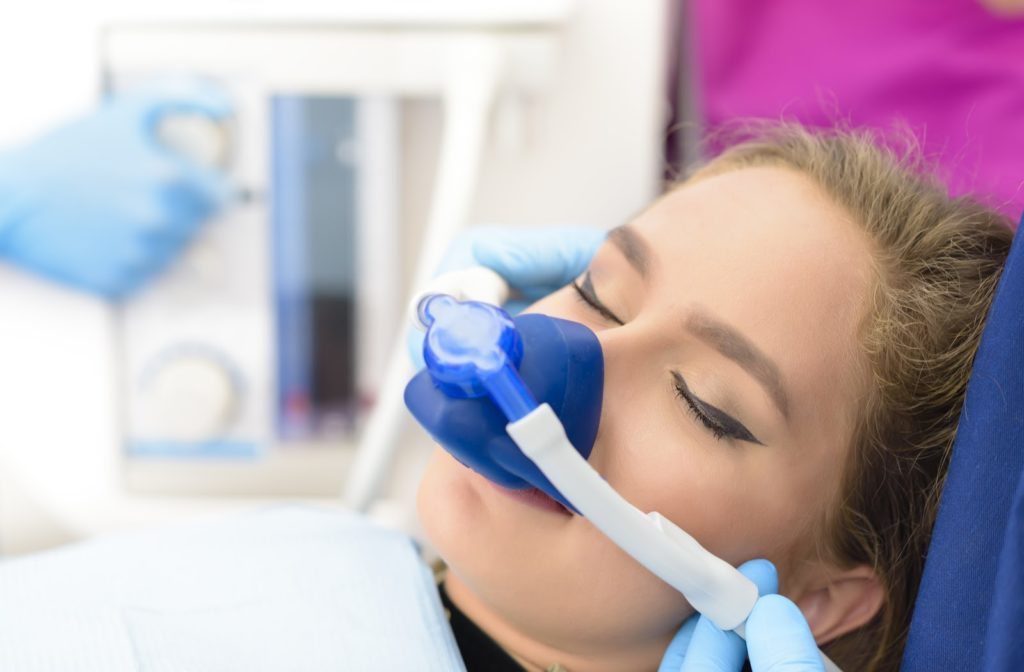What is Sedation Dentistry?
For many people, trips to the dentist are uncomfortable and, in some cases, scary. Dental anxiety, or dental fear, is estimated to affect over 30% of the population, with over 10% of that suffering from extreme dental phobia.
Sedation dentistry can effectively reduce patient anxiety, allowing you to relax during procedures that may typically cause significant distress. Different types of sedation dentistry can be used depending on the level of discomfort and what needs to be done.
Levels of Sedation
There are a few different levels of sedation that can be used to help you relax during dental procedures. However, it’s important to note that dentists in Alberta are no longer allowed to provide deep sedation or general anesthesia. Most dental practices offer local anesthetic and minimal sedation, which is typically sufficient for most people that have dental anxiety.
Levels of sedation dentistry include:
- Minimal sedation, which allows you to relax without putting you to sleep.
- Moderate sedation, which is similar to minimal sedation but at a larger dose for a stronger effect.
- Deep sedation, which puts you on the edge of consciousness, but you can still wake up.
- General anesthesia, which puts you to sleep completely.
If you require deep sedation or general anesthesia, it’s best to consult your dentist to discuss your options.
What Types of Sedation are Used?
Depending on what type of procedure you are getting done, your dentist will recommend what kind of sedation might be best for you.
The most common types of sedation are:
- Inhaled sedation is commonly used for minimal sedation. You will have an oxygen mask placed over your nose so you can comfortably inhale nitrous oxide or “laughing gas.” This type of sedation wears off quickly, so the dose can be precisely controlled by your dentist.
- Oral sedation can be used for both minimal and moderate sedation. Oral sedation is administered in pill form and should be ingested around an hour before your procedure. This sedation type will likely make you feel drowsy, and you may fall asleep, but you can be awakened easily.
- IV sedation is administered directly into a vein, so it takes effect quickly. IV sedation is typically used for moderate sedation, and the dose can be adjusted continually.
Alongside sedation, you will likely be given a local anesthetic to numb the treatment area. This is typically administered with a thin needle to reduce any pain and discomfort felt during the procedure.
Who Might Need Sedation Dentistry?
Sedation can make a trip to the dentist far less nerve-wracking and can be the difference between getting much-needed work and avoiding the dentist altogether. Typically, sedation is beneficial for people that have dental anxiety. However, it can also be helpful for those who:
- Have a low pain threshold
- Have trouble sitting still
- Have extremely sensitive teeth
- Have a sensitive gag reflex
- Need significant work done
Your dentist can calm your nerves before your procedure by explaining what needs to be done and why. They can also accurately recommend sedation and local anesthetic to make your procedure more comfortable.
Sedation FAQs
Is Sedation Safe?
Although there are risks involved with any medical procedure, getting anesthesia is generally considered to be safe. Individuals that are obese or have obstructive sleep apnea may be at risk of complications from anesthesia.
It’s important to discuss your medical history with your dentist to ensure you are unlikely to develop complications.
Is Sedation Safe for Children?
Minimal sedation in the form of nitrous oxide is typically safe for children as the dose can be adjusted to suit the height and weight of a child.
This type of sedation can be beneficial for children that are terrified of the dentist or have a disability, as it wears off quickly.
Will I Still Feel Pain?
Your dentist will likely administer local anesthetic if you are undergoing a procedure that may be painful. The local anesthetic will numb the area, so you should feel nothing more than pressure during your treatment. Coupled with sedation, it’s unlikely you will feel any pain.
However, if you are very sensitive to pain or metabolize anesthesia quickly, it’s important to mention this to your dentist. They will help create a plan that will work best for you.
Are There Any Side Effects?
The effects of sedation used in most dental offices will wear off in a few hours, but you may experience some mild side effects. Depending on the strength of the sedation, you may feel sluggish for a while after the procedure.
Some other common side effects include:
- Drowsiness
- Loss of memory of what happened during the procedure
- Slow reflexes
- Low blood pressure
- Headache
- Nausea
At Shawnessy Dental Centre, we are committed to ensuring your experience is comfortable. Please give us a call if you have any questions!



